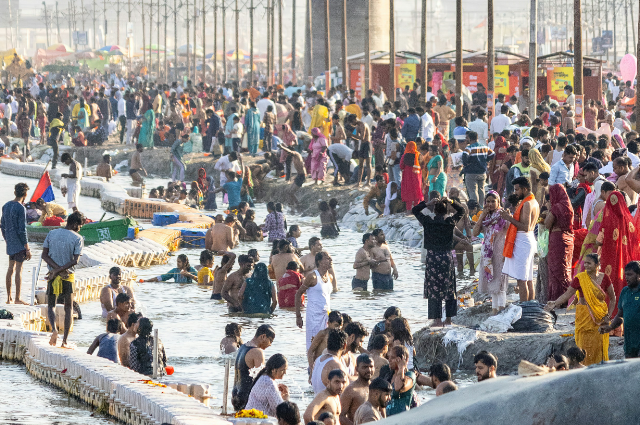
Photo by Gautam Krishnan on Unsplash
The celebration is marked by a ceremonial dip in the waters. Along with a number of fairs, education, saints' religious talks, large monastic assemblies, and entertainment, it is also a celebration of local business. The seekers think that soaking in these waters absolves them of their sins and serves as a way to prāyaścitta (atonement, penance, restorative action) for previous transgressions. Similar but smaller communal pilgrimage and bathing celebrations are known as the Magha Mela, Makar Mela, or something similar in several regions of India. For instance, the Magha Mela, which includes a water-dip ceremony, is an ancient celebration in Tamil Nadu. Held annually at Kumbakonam's Mahamaham Tank (near the Kaveri River), this celebration has been dubbed the Tamil Kumbh Mela and draws millions of South Indian Hindus.
Kurukshetra, Rajim, Sonipat, and Panauti (Nepal) are other locations where the Magha-Mela or Makar-Mela bathing pilgrimage and festivals have been referred to as Kumbh Mela.
Hindu mythology describes the creation of a "pot of amrita (nectar of immortality)" after the forces of good and evil churn the ocean of creation. The gods and demons fight over this pot, the "kumbha", of nectar in order to gain immortality. In a later day extension to the legend, the pot is spilt at four places, and that is the origin of the four Kumbha Melas. Some claim that Vishnu is the Mohini avatar, while others claim that Dhanavantari, Garuda, or Indra are revealing the truth. The earliest references to the original tale of Samudra Manthana (churning of the ocean), such as the Vedic era literature (pre-500 BCE) or the earliest of the Puranas (3rd to 10th-century CE), do not contain this "spilling" and related Kumbh Mela story. Although the phrase "Kumbha Mela" is absent from ancient and medieval literature, Hindu texts have many chapters and lyrics concerning a bathing festival, the trip to Prayag, and the sacred confluence of the Ganga, Yamuna, and Saraswati rivers. The Snana (bathe) rite and the Prayag Mahatmya (greatness of Prayag, Sanskrit for historical tour guides) are two examples of this.
For all pilgrims, the main Kumbh Mela practice is bathing, or taking a plunge in the river waters while praying. Hindu pilgrims typically greet and wait for the thirteen sadhu akharas to take a bath first on Amavasya, the most treasured day for bathing. The monks, some of whom are covered in bhasma (ashes), participate in a festive processional march that is highlighted by banners, flags, elephants, horses, and musicians. This ceremony is known as Shahi San or Rajyogi San. These monastic establishments are from various regions of India and are associated with a certain god and emblem (e.g., Hanuman, Dattatreya, Ganesha, etc.). With headquarters at Sringeri, Dvarka, Jyotirmatha, and Govardhana, the four biggest Hindu monasteries in India are represented by the largest contingent, the Juna Akhara, which may be traced back to Adi Shankara.
The other sizable contingents are the Mahanirbani and Niranjani, and each akhara has its own tradition of saints and scholars. Huge crowds assemble to applaud and show respect for this monastic procession. The festival day opens for pilgrims from far and near the location to bathe after these monks have done so. A Prayagwal priest may assist the pilgrims in their bathing rite, or it may be as simple as a private plunge. Mundan (head shaving), prayers with offerings of flowers, sindur (vermilion), milk or coconut, and the recital of hymns with shradha (prayers in honor of one's ancestors) are some of the rituals that, with assistance, may start.
More complex rituals involve a priest-led yajna (homa). Following these riverside rites, the pilgrim gets out of the water, stands up, prays for a little while, and then dips into the water. After that, many go to nearby ancient Hindu temples. There are multiple reasons why people perform the bathing routine. The most significant is the idea that washing in these sacred waters after making the tirtha (pilgrimage) to the Kumbh Mela sites has salvific significance, or moksha, a way to be freed from the cycle of rebirths (samsara). In Hindu teachings, pilgrimages are also advised for people who have sinned or made mistakes in order to repent and to perform prāyaścitta (penance, atonement) for their transgressions. Hinduism's early dharma literature discusses pilgrimages and bathing in sacred rivers as a way to purify oneself and perform penance. These practices have Vedic origins. The king Yudhisthira, for instance, is portrayed in the epic Mahabharata as being in a state of grief and despair following his involvement in the bloody great war that claimed many lives. He visits a saint, who suggests that as a penance, he make a pilgrimage to Prayag and take a bath in the Ganges.
Millions of people participate in the ceremonial dip in the Ganges River because they firmly believe in its purifying properties, despite its legendary origins. Participants claim that taking a bath at particular celestial alignments grants spiritual merit and cleanses sins. It's crucial to remember that modern circumstances make this idea more difficult to understand. Urban runoff and industrial waste are the main sources of pollution in the Ganges River. As a result, there is a conflict between faith and environmental issues; while followers interact closely with their mythologically based spiritual beliefs, they also have to deal with environmental issues that endanger the very waterways they hold in high regard.
To sum up, the Mahakumbh Dip is an important religious celebration that also offers insight into Hinduism's larger cultural traditions. A continuous conversation between tradition and modernity is highlighted by the blending of legendary importance with contemporary realities. Despite environmental constraints, the fact that millions of people continue to converge for this historic event in search of spiritual emancipation and purification through their faith rituals highlights the complexity and force of devotion.
